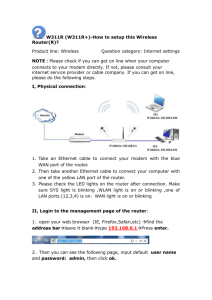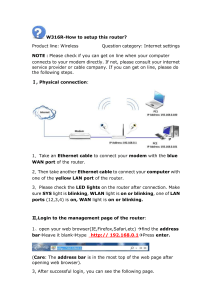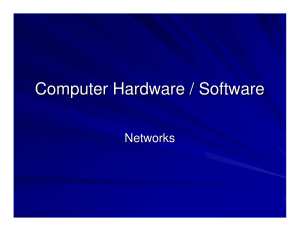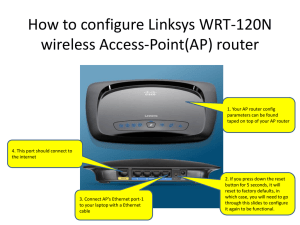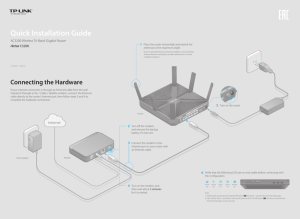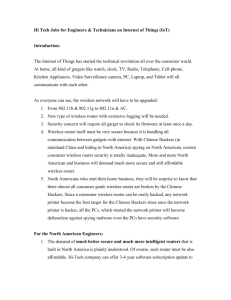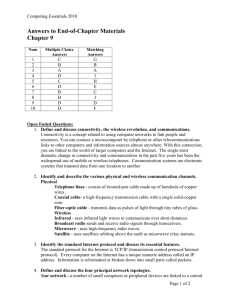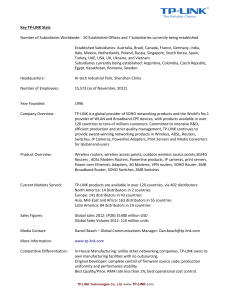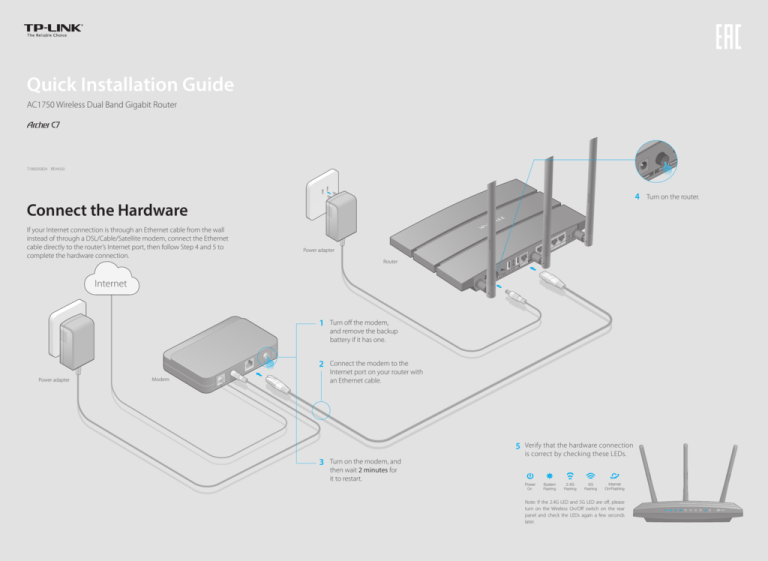
Quick Installation Guide
AC1750 Wireless Dual Band Gigabit Router
7106505824 REV4.0.0
4
Connect the Hardware
If your Internet connection is through an Ethernet cable from the wall
instead of through a DSL/Cable/Satellite modem, connect the Ethernet
cable directly to the router’s Internet port, then follow Step 4 and 5 to
complete the hardware connection.
Power adapter
Router
Internet
Power adapter
1
Turn off the modem,
and remove the backup
battery if it has one.
2
Connect the modem to the
Internet port on your router with
an Ethernet cable.
Modem
5
3
Turn on the modem, and
then wait 2 minutes for
it to restart.
Verify that the hardware connection
is correct by checking these LEDs.
Power
System
2.4G
5G
On
Flashing
Flashing
Flashing
Internet
On/Flashing
Note: If the 2.4G LED and 5G LED are off, please
turn on the Wireless On/Off switch on the rear
panel and check the LEDs again a few seconds
later.
Turn on the router.
Configure via Web Browser
1. Connect your computer to the router (Wired or Wireless)
Wired
USB Features
C Choose the frequency you prefer and then click ‘Next’.
Use the USB ports for media sharing, storage sharing and printer sharing across your local
network. You can also set up an FTP server to access your files remotely through the Internet.
Quick Setup - Wireless Dual Band Selection
Concurrently with 2.4GHz and 5GHz (802.11a/b/g/n/ac)
Only work in 2.4GHz (802.11b/g/n)
Only work in 5GHz (802.11a/n/ac)
Ethernet cable
Back
Next
Wireless
Use the default wireless network name (SSID) and password printed on the product label at the bottom
of the router to connect wirelessly.
D Verify or Change the Wireless Network Settings. Click ‘Next’ to continue.
Note: You may customize your 2.4GHz/5GHz wireless network name and password. Once done, the wireless
connection will disconnect automatically, and you must then use the new wireless network name/password to
regain access to the Internet.
Twin USB sharing ports
Remote Access
via FTP Server
Media Sharing
Local Storage
Sharing
Printer Sharing
Quick Setup - Wireless 2.4GHz & 5GHz
Wireless Network Name (SSID):
Region:
TP-LINK_A4B4/TP-LINK_A4B3_5G
United States
Note: To learn more about the USB features, retrieve the Resource CD
attatched in the package, visit the website http://tp-link.com/app/usb, or
simply scan the QR code with your smart devices.
Wireless Security:
Disable Security
Enable Security (WPA-PSK/WPA2-PSK)
12345670
PSK Password:
2. Configure the router with a web browser
No Change
Back
A Enter ‘http://tplinkwifi.net’ or ‘http://192.168.0.1’ in the address bar of a web
browser. Use ‘admin’ for both user name and password, and then click ‘Login’.
Note: If the login window does not appear, please refer to FAQ->Q1.
Next
E Finish the configuration.
Q1. What can I do if the login window does not appear?
Quick Setup - Finish
http://tplinkwifi.net
Congratulations!
The basic Internet and wireless settings are finished, please click Finish button and test your internet
connection. If it fails, please reboot your modem and wait 2 minutes or run the Quick Setup again.
admin
admin
Back
Finish
A1. If the computer is set to a static or fixed IP address, change the setting to obtain an IP
address automatically.
A2. Verify that ‘http://tplinkwifi.net’ or ‘http://192.168.0.1’ is correctly entered in the web
browser. Alternatively, enter ‘http://192.168.1.1’ in the web browser.
A3. Use another web browser and try again.
A4. Reboot your router and try again.
A5. Disable then enable the network adapter in use again.
Q2. What can I do if I cannot access the Internet?
Login
Copyright © 2015 TP-LINK Technologies Co., Ltd. All rights reserved.
B Click ‘Quick Setup’ on the left menu, and click ‘Next’. Select your Connection
Type and if you are unsure of what your connection type is, select
‘Auto-Detect’. Click ‘Next’ and follow the instruction to continue.
Configure via Tether App
TP-LINK's Tether app lets you conveniently access the router and:
View information about the clients on your network.
Quick Setup - WAN Connection Type
Block network access from specific users or devices.
Set up Parental Controls with access time and content restrictions.
Auto-Detect
Change the basic wireless network settings easily.
Dynamic IP (Most Common Cases)
Static IP
Then, how to begin?
PPPoE/Russian PPPoE
L2TP/Russian L2TP
1 Scan the QR code and download the TP-LINK Tether App from
PPTP/Russian PPTP
Note: For users in some areas (such as Russia, Ukraine etc.), please contact your ISP to choose
connection type manually.
Back
FAQ (Frequently Asked Questions)
Next
the Apple App Store or Google Play.
2 Ensure your smart device is wirelessly connected to the home
network.
3 Launch the Tether App, and start managing your home network.
A1. Check if the Internet is working properly by connecting a computer directly to the
modem via Ethernet cable. If it is not, contact your Internet Service Provider.
A2. Open a web browser, enter ‘http://tplinkwifi.net’ or ‘http://192.168.0.1’ and try to set up
again.
A3. Reboot your router and try again.
A4. For cable modem users, reboot the modem first. If the problem still exists, log in to the
Web Management page of the router, and go to ‘Advanced’ -> ‘Network’ -> ‘MAC Clone’,
click on ‘Clone MAC Address’ and then click on ‘Save’.
Q3. How do I restore the router to its factory default settings?
A1. While the router is powered on, press and hold the ‘Reset/WPS’ button on the back
until the power LED blinks.
A2. Log in to the Web Management page of the router, and go to ‘Advanced’ -> ‘System
tools’->’Factory Defaults’, click ‘Restore’, then wait until the loading progress bar completes.
Q4. What can I do if I forget my web management password?
A. Restore the router to its factory default settings and then use the default User Name
and Password ’admin’ to log in.
Q5. What can I do if I forget my wireless network password?
A. Log in to the router’s Web Management page, and then go to ‘Basic’->’Wireless’ to
obtain the wireless password.
©2015 TP-LINK

